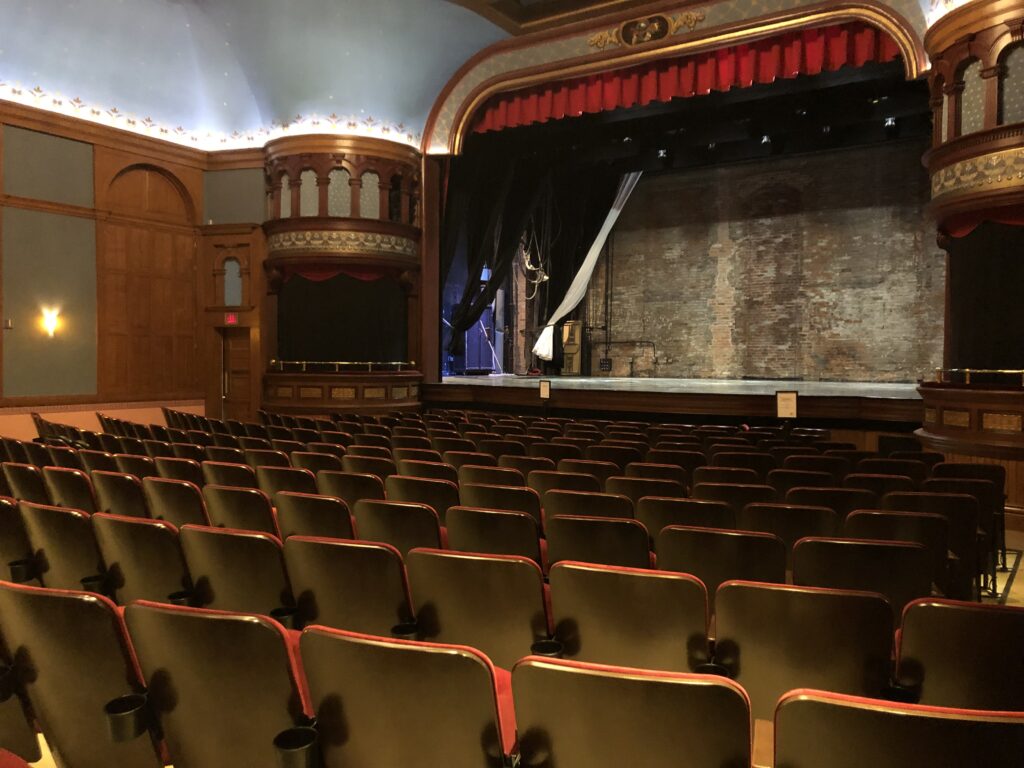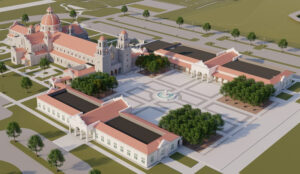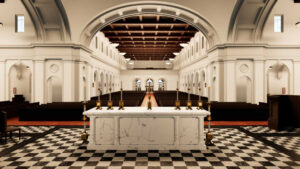Historic Wheeler Opera House in Aspen, Colorado Installs Hearing Loop System



Assist2hear is excited to announce the final completion of another new Colorado hearing loop installation at the Wheeler Opera House in Aspen, Colorado. The installation includes hearing loops in both the orchestra and balcony of the historic Aspen music venue. The décor of the theater now consists of new, lush, carpet in the aisles and original flooring within the seating area of the orchestra, and full carpet in the balcony. The hearing loop design for both segments is a phased array system.
A huge part of hearing loop installation in theaters is maintaining the integrity of a venue’s décor, particularly when working with a historic theater. The Wheeler Opera House opened its doors to the Aspen community in 1889, making it 132-years old today. The necessity for a phased array installation in historic venues such as this requires the experience and custom finishing expertise that only Assist2Hear brings to the table, with over ten years of Contacta field-certified hearing loop installation
Phased arrays hearing loop systems ensure a uniform sound for all users, regardless of seating location. They are a best practice for large theaters due to key factors such as size and rise of seating. The Wheeler Opera House required a phased array design in its orchestra because of the large size and the in the balcony primarily because of its rise. Theater patrons will have to look hard to find any indication of wires, as they are well hid either underneath carpet or seats “disguised as a shadow”.
What does “disguised as a shadow” look like? We hope you will go, enjoy the theater’s new hearing loop, and see for yourself. The Wheeler Opera House reopens its doors to the Aspen Community for the Aspen Music Festival taking place July 1st through August 22nd. For more upcoming events at which to enjoy the Wheeler’s new hearing loop, visit AspenShowTix.com.

Hearing Loops at New Catholic Shrine Site
Oklahoma Catholics with hearing loss will have the best sound in the house when they worship at the Blessed Stanley Rother Shrine next year. The site will house a 2,000 seat Catholic church, the largest in Oklahoma, as well as the Blessed Stanley Rother shrine and an educational complex. In addition to being the largest Catholic church in Oklahoma, the church and chapel on the shrine site will also include induction hearing loop technology for worshipers. The hearing loop systems will bring the Word of God directly to the ears of Catholic worshipers with hearing loss and eliminate the echo, reverberation, and ambient noise that often make hearing in church extremely difficult.
Why Catholic Churches Need Hearing Loop Technology
Traditionally, Catholic churches are beautifully cavernous structures with high ceilings and hard surfaces. Unfortunately, the construction of these spaces also causes sound to bounce, a factor that no amount of money spent on a sound system can overcome for a person with hearing loss. In these types of spaces, the ability to hear the Word clearly and intelligbly is nearly impossible for people with hearing loss unless a hearing assistive technology, such a s hearing loop, is utilized. With hearing loop technology, all of the peripheral sounds of a space are filtered out and the sound from the audio system comes directly to the user’s ear. With a telecoil-enabled hearing aid, the Word of the Lord comes directly to their hearing aid wearer’s ear, as clearly as if the Father was sitting on their shoulder giving the sermon! The user simply needs to switch their own personal hearing aid to the telecoil program in order to access the technology – there is no need for additional equipment. If a user does not have a telecoil-enabled hearing aid, then utilize a receiver, however, most people enjoy the system by simply using their own hearing aids.


The History of the Blessed Stanley Rother
Father Stanley Rother was born and raised in Okarche, Oklahoma in 1935. He joined the priesthood in 1963, and in the 1970s brought the Word to worshipers in the parish of Santiago Atitlan, Guatemala. While preaching in Guatemala, a civil war between the militarists and guerillas killed thousands of Catholics. Despite the threat to his safety, Father Rother continued to teach the Word and educate the people of Guatemala. In 1981, Father Rother was executed for his refusal to abandon his people in the time of war. He is the first martyer in the United States and the first U.S.-born priest to be beatified, according to the Archdiocese of Oklahoma. His heart remains enshrined in Guatemala to this day. Visit the website of the Archdiocese of Oklahoma at https://www.archokc.org/stanleyrother for his full biography.
Hearing Loops in Oklahoma Catholic Churches
Hearing loops are in many Catholic churches in the Oklahoma City corridor, including St. Thomas Moore in Norman, Holy Spirit in Mustang, and St. Eugene’s in Oklahoma City. When in the Tulsa area, Catholics with hearing can enjoy the Word through hearing loops located at the Catholic Church of St. Mary or Holy Family. Assist2Hear is the installer for all Oklahoma hearing loops listed, with the exception of Holy Family. For more Oklahoma hearing loop locations, click here .
Since 2010, Assist2Hear has been a leading national installer of induction hearing loop systems throughout the U.S. If your church would like a quote on a hearing loop, email us at info@assist2hear.com. For more information on how hearing loops can help people in your church better hear the Word, please visit our blog post Hearing Loop Systems in Churches.
For more information on the Blessed Stanley Rother Shrine, please visit the Catholic Diocese of Oklahoma’s dedicated page at https://archokc.org/shrine.
Fireworks are fun but the can also cause hearing loss.
As the 4th of July approaches, plans for fireworks and festivities abound. Even though a huge part of the fun of fireworks is their explosion and the sound it makes, it is incredibly important to take safety precautions when setting them off. Fireworks, as well as other loud noises, can be extremely dangerous to one’s hearing. If not carefully enjoyed, fireworks can cause hearing loss that will last a lifetime. The good news is that with two simple considerations, you can prevent hearing loss this 4th of July.
Distance
The closer you are to the fireworks display, the louder it is going to be. While it is fun to where the action is, it is also important to remain a safe distance from fireworks to minimize the sound and potential for damage to hearing. According to the World Health Organization, a safe distance from fireworks for an adult is approximately 30 to 45 feet. Be careful though because the safe distance for children is much higher; children need to be at least 150-180 feet away to minimize the possibility of hearing damage due to fireworks. To put that into perspective, 94 feet is the length of an NBA-size basketball court.
Wear Ear Protection
Explosive sounds, like firecrackers, are even more hazardous to your hearing than other loud noises. When igniting fireworks, it is incredibly important to wear ear protection. A variety of ear protection options exist, from cheap foam earplugs available at the gas station to midrange and high-end noise-canceling headphones. Headphones on their own are generally not recommended unless they cover the ears in their entirety. If noise-canceling functionality is not available, it is recommended to use a foam earplug, in addition to the headset. Oh – and we forgot to mention using one’s noise-canceling Airpods works great too!
Resources for Hearing Loss
If you need help due to a hearing loss incident with fireworks or are simply experiencing hearing loss in general, there are places that can help. A simple Google search can locate a local audiologist who can provide a hearing test to quantify how much hearing loss is present and what to do next. In many cities, there are chapters of the Hearing Loss Association of America (https://www.hearingloss.org), which can connect people with hearing loss to local resources, as well as provide a wealth of information and support for people experiencing hearing loss.
Don’t let accidental over-exposure to fireworks on the 4th of July affect you or your child’s ability to hear normally for the rest of their life. Have fun, but be safe!
One afternoon, while my parents were gone to a doctor’s appointment, a friend and I installed a home hearing loop in my parent’s living room. In less than 30 minutes, we crawled around the living room, tucking the thin wire under the baseboards. The wire ends connected easily to a small hearing loop amplifier which connected to the television.
I often hear “negatives” about television. Too much television usually means not enough physical activity, laziness, or wasting time. But in my father’s case, television is his happy place.
My father’s life consisted of kissing my mother goodbye in the morning and zooming around Oklahoma City. He was a chaplain for Integris Medical Center and Mercy Hospital. He was also a deacon to Holy Angels Catholic Church in Oklahoma City. His spare time was filled with family and hunting for his next hobby; he barely sat still. Unfortunately, he had a massive stroke in December 2015 and it changed everyone’s life.
As a stroke survivor, his day is a little slower now and revolves around doctors’ appointments and a lot of rest.
After becoming one of his main caregivers, I started to understand what a big impact hearing loss has in his every day life. At first, I encouraged him to get out of the house with me. I encouraged him to try movies, book readings, and special presentations throughout the city. For months we tried similar outings and every event had a similar outcome:
“What did you think about the [insert activity]?” And he would shrug shoulders and just say “I couldn’t really hear it.”
Even when we went to his favorite restaurant, I could tell he was there just to eat; he definitely wasn’t there to have a conversation with us because he couldn’t understand our words over the normal commotion of a restaurant atmosphere.
His hearing loss encourages him to stay home. At least at home, he could turn the TV up as loud as he wanted to watch a church service and actually hear the sermon. He could be transported to downtown City Hall and make sense of City Council meetings. He could learn all about the famous artists visiting the museum without having to leave his living room.
But the television volume was driving us all crazy, especially my sweet mother. About the time my mother was about to throw the television out the front door, I introduced them to a residential hearing loop.
One afternoon, while my parents were gone to a doctor’s appointment, a friend and I installed a home hearing loop in my parent’s living room. In less than 30 minutes, we crawled around the living room, tucking the thin wire under the baseboards. The wire ends connected easily to a small hearing loop amplifier which connected to the television.
I had previously made sure the Telecoil or T-coil was activated in both of my parent’s hearing aids. I knew they were hearing loop ready!
My dad loves watching cooking shows after therapy sessions so that he will have “sweet dreams” during his nap. I had turned the volume down significantly and his first reaction was to grab the remote and turn up the volume to 742. But instead, I asked them to switch the programs in their hearing aids to a T-coil mode.
As soon as the Telecoil program mode was turned on, he and my mother looked straight at each other with wide eyes to confirm what they were hearing. Instead of the television being at volume 50 (or 742!), the television volume was extremely low. They realized they could hear PERFECTLY and at the PERFECT volume through their hearing aids even though the TV was basically muted. My mother started laughing and my father looked at me like I had bought him the best Father’s Day gift ever.
I explained how hearing loop technology worked. In basic terms, a thin wire is laid around the room and connected to an amplifier and a sound source- in this case the television. The signal from the television travels through the hearing loop amplifier and loop wire, creating an electro-magnetic field. The telecoil inside of most hearing aids and hearing devices, works as an antenna to pick up the signal. The clear sound is delivered straight to the hearing device!
Hearing loop technology has been around for over 30 years and it is used around the world to help individuals live well with hearing loss. Television hearing loops help my father relax and enjoy his favorite shows instead of struggling to make sense of the dialogue. Some people struggle with low frequency sounds like vowels, while others struggle with high frequency sounds like consonants. Just imagine trying to make sense of a sentence without the vowels. Could you do it?
Hrng Lps rlly hlp n th hm and cmmnt. Hrng lp tchnlg hlps brng clr snd strght t yr hrng dvc!
(Home hearing loops really help in the home and community. Hearing loop technology helps bring clear sound straight to your hearing device!)
Assist2Hear proudly offers a hearing loop solution in our Home Hearing Loop Kit. The residential hearing loop kit can be purchased as a room loop which includes the amplifier, power supply, 100’ of 20 gauge wire, TV patch cords (RCA), self-install instructions. A hearing loop chair pad is also available which can be used under a chair or sofa. The loop pad works for the single user, while the room kit works for many people. Professional installation is available in select cities for an additional charge.
My father won’t enjoy his day without his Television Home Loop and would like one in every room- including the kitchen! Residential hearing loops really help!


